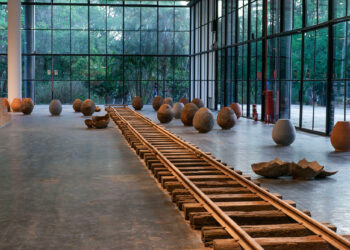Performa, the internationally acclaimed organisation dedicated to live interdisciplinary performance by visual artists, is pleased to announce the roster of Performa Commissions for the tenth Performa Biennial, featuring new works by Julien Creuzet, Marcel Dzama, Nikita Gale, Nora Turato, Franz Erhard Walther, and Haegue Yang, in addition to the specially commissioned Performa Hub by Assaf Kimmel.

Marcel Dzama, A musical portrait of Federico Garcia Lorca, 2022. Courtesy the artist and David Zwirner. © Marcel Dzama
Taking place over a period of almost three weeks, from November 1–19, 2023, Performa once again celebrates the extraordinary vitality, inventiveness, and significance of New York as the leading global performance capital of the world. Commissioned artists work closely with Performa curators and producers over an extensive period to develop uniquely ambitious projects, often combining disciplines and seeking out new collaborators, to present radical work in spaces across the city – some creating live performance for the very first time.
French-Caribbean artist Julien Creuzet (b. 1986) will present a new performance that continues his explorations into the history of trade, displacement, and diaspora. In collaboration with Brazilian choreographer Ana Pi, Creuzet’s first large-scale choreographic work will draw on a collection of movements that he has culled from social media over several years. All generated by content creators of African descent, they unveil unexpected, yet intimate, connections between steps that exist in different times and geographies across the Black Atlantic. Including performers from the United States, the Caribbean, and Europe, Creuzet’s performance will feature movement, soundscapes, and a series of sculptural objects created by the artist. Creuzet’s Performa Commission will be co-commissioned by the Hartwig Art Foundation.
Canadian-born, New York-based artist Marcel Dzama (b. 1974) – who draws from folk vernacular, Surrealist film, Dada whimsy, and Soviet agitprop to create lush, dreamlike works on paper and other media – will transform his immediately recognisable visual language into a many-layered performance including live musicians, animated film, and dance. Inspired by “Trip to the Moon” (1929) – a poem by Spanish poet and playwright Federico García Lorca that was written during the writer’s ten-month sojourn in New York that yielded his most famous collection of poetry, Poeta en Nueva York – Dzama will stage an interpretation of the poem through song, spoken word, video, and intricate sets, costumes, and props designed by the artist himself. A co-production by Performa and the Federico García Lorca Foundation in Madrid, Spain, it will be presented at Abrons Art Center in the historic Playhouse Theater.
Alaska-born, Los Angeles-based artist Nikita Gale (b. 1983) will present the artist’s first live performance combining live music, light, and sound with atmospheric conditions in a meditation on the transitory nature of weather, featuring a live ensemble of classical musicians. Creating an entirely ephemeral and visceral experience, Gale’s performance installation will capture the volatility and essence of the four seasons, an increasingly unpredictable unit of measure in the rapidly changing environmental conditions of the globe.
German conceptual artist Franz Erhard Walther (b. 1939), whose work since the 1960s has radically reimagined relationships between space, objects, and bodies using fabric and soft canvas for his free standing and wearable sculptures, will present a survey of participatory activations at the Judd Foundation, housed in the iconic space of Donald Judd’s former home and studio in SoHo. With directions provided by Walther, users will be invited to manipulate and wear his forms, expanding together the notion of sculpture through action. This unique restaging of Walther’s seminal works is coproduced by Performa and Judd Foundation.
Berlin and Seoul-based artist Haegue Yang (b. 1971) will revisit The Malady of Death, a novella by legendary French author and filmmaker Marguerite Duras (1914–1996) reconfigured as a live reading by a single performer. Written in 1982, Duras’s text explores a mysterious encounter between two figures, identified in the text as “You” and “She,” isolated in a hotel room as they explore “how to love.” With its fragmented structures and its minimal voice, the text is a prime example of Duras’s experimental writing style. As a long-term obsession and artistic project of Yang’s, this text has been revisited by the artist many times since her first public reading at the Walker Art Center in 2010. Co-produced with the Solomon R. Guggenheim Museum, Yang’s Performa Commission will be the sixth iteration of The Malady of Death and will take place at the Museum’s Peter B. Lewis Theater.
Known for her text-based works and performances addressing the possible meanings of language in a culture oversaturated with information, Croatian born, Amsterdam-based artist Nora Turato (b. 1991) will create a monologue exploring personal transformation, staged within the distinct architecture of the Society for Ethical Culture on Manhattan’s Upper West Side, a space dedicated to ethics, social justice, and democracy. Turato’s bold graphic designs will also be displayed in the city, extending the messages of her live performance into the subconscious of the public as they go about their daily lives.
Berlin-based architect and curator Assaf Kimmel (b. 1991) has designed the Performa Hub, a specially commissioned space to host talks, events, and community gatherings in Downtown Manhattan for the duration of the Biennial. Inspired by the intersection of art, fashion, and architecture, Kimmel’s flexible space will be a multipurpose venue for sound installations, screenings, and the full debut of Performa’s archives as well as a selection of key archival collections from around the world.
Since its inception in 2005, Performa has brought together a network of New York City’s cultural institutions and non-profit spaces that shape the cultural fabric of the city, alongside major international partnerships in co-productions and co-presentations. For 2023, these include a co-production with the Federico García Lorca Foundation; co-presentations with Abrons Art Center, Judd Foundation, and the Solomon R. Guggenheim Museum; along with a special partnership between Dia Art Foundation and New York Live Arts, which together will present the New York premiere of Boy mother / faceless bloom, by Juni One Set, an ensemble that includes Senga Nengudi, eddy kwon, and Haruko Crow Nishimura and Joshua Kohl of Degenerate Art Ensemble. The work is presented in conjunction with the long-term exhibition of Nengudi’s work on view at Dia Beacon and will be staged at New York Live Arts as part of the Performa Biennial 2023.
RoseLee Goldberg, Founding Director and Chief Curator states: “Performa has always been a highly collaborative endeavor, founded upon the belief that the city is home to some of the most imaginative and visionary artists, curators, and organizations who combine forces to maintain Performa as one of the most anticipated festivals on the international cultural calendar.” The history anchor began in 2009 with a celebration of the one-hundred-year anniversary of Italian Futurism and its wide-ranging impact on the trajectory of performance, visual art, and culture. Each Biennial since then has concentrated on a seminal historical movement as a lens through which to revisit and rewrite important episodes within art history, including Russian Constructivism (2011), Surrealism (2013), the Renaissance (2015), Dada (2017), and the Bauhaus (2019). Performa’s role as a museum without walls is deeply committed to informing artists, art historians and the general public about the history of performance art, or live art by visual artists, from the Renaissance to the present. In addition, its curatorial and production capacities make it the leading organization of its kind worldwide.
This year, Performa examines the “big bang” of conceptual art of the 1960s and 1970s that exploded around the world, changing the very nature of visual art, the shape and content of exhibitions, as well as the foundation of art education. The particles from that big bang continue to fall all around us, driving form and content almost six decades later.
Additional programs for the Performa Biennial 2023, including programming at the Performa Hub and the full artist list for the Finnish Pavilion Without Walls, will be announced in the coming months. For more information, please visit Performa.



